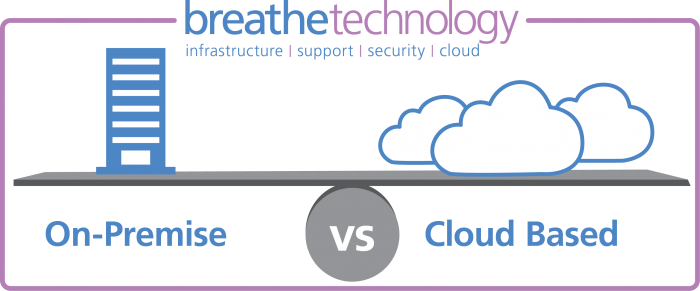Lucy at Breathe Technoology writes:
If you are wondering which option is more secure, accessible and affordable, explore our handy comparison.
‘The cloud’ has grown in popularity in recent years and, according to Gartner, there were 72 percent of businesses using cloud software models in 2015. Bringing freedom from hardware constraints, to agility and always-current functionality, it’s hard to deny its benefits. Yet cloud vs on-premise software continues to be hotly debated.
Cloud vs On-Premise Software Comparison
Essentially, the fundamental difference between cloud vs on-premise software is where it resides. On-premise software is installed locally, on your business’ or schools’ computers and servers, where cloud software is hosted on the vendor’s server and accessed via a web browser.
As well as accessibility, there are a raft of other things that need to be considered when making a decision, including software ownership, cost of ownership, software updates and additional services, such as support and implementation. Here we explore all the pros and cons…
CLOUD SOFTWARE ADVANTAGES:
Anywhere and anytime access – You can access your applications anytime and anywhere via a web browser from any device.
Affordable – Cloud requires no upfront costs, instead you make regular payments which makes it an operating expense (OpEx). While the monthly cost adds up over time, maintenance and support services are included removing the need for annual contracts.
Predictable costs – Benefit from predictable monthly payments that cover software licences, upgrades, support and daily back-ups.
Worry-free IT – Because cloud software is hosted for you, you don’t need to worry about the maintenance of your software or the hardware it resides on, compatibility and upgrades are taken care of by the cloud service provider.
High levels of security – Data centres employ security measures beyond the affordability of most businesses, therefore your data is often safer in the cloud than on a server in your offices.
Quick deployment – Cloud-based software is deployed over the Internet in a matter of hours/days because, compared to on premise applications which needs to be installed on a the physical server and each PC or laptop.
Scalability – Cloud technologies provide greater flexibility as you only pay for what you use and can easily scale to meet demand, for example adding and scaling back licences.
Lower energy costs – When you move to the cloud, you no longer have to pay to power on-premise servers or to maintain their environment. This significantly reduces the amount you pay on your energy bills.
CLOUD SOFTWARE DRAWBACKS:
Connectivity – Cloud solutions require reliable internet access for you to remain productive.
Long-term costs – Although requiring a lower upfront investment, cloud applications can be more costly over the course of the system’s life cycle, increasing Total Cost of Ownership (TCO).
Less customisable – Cloud software is typically configurable but depending on how it is hosted a cloud solution may not be able to cope with complex development.
On-premise deployments
ON-PREMISE ADVANTAGES:
Total Cost of Ownership – Since you are only paying for your user licences once, an on-premise solution can have a lower Total Cost of Ownership (TCO) than a cloud system.
Complete control – Your data, hardware and software platforms are all yours. You decide on the configuration, the upgrades and system changes.
Uptime – With on-premise systems, you do not rely on internet connectivity or external factors to access your software.
ON-PREMISE DRAWBACKS:
Large capital expenditure – On-premise systems usually require large upfront purchase which means capital expenditure (CapEx) is often required. On top you need to include maintenance costs to ensure support and functionality upgrades.
Responsibility for maintenance – With an on premise system, you are responsible for maintaining server hardware and software, data backups, storage and disaster recovery. This can be an issue for smaller companies who have limited budgets and technical resources.
Longer implementation times – On-premise implementations take longer due to the time needed to complete installations on servers and each individual computer/laptop.
Why is cloud better than on-premise?
Dubbed better than on-premise due to its flexibility, reliability and security, cloud removes the hassle of maintaining and updating systems, allowing you to invest your time, money and resources into fulfilling your core business strategies. Providing real-time access to systems and data from a variety of devices regardless of the location and with guaranteed up-time of 99%, cloud is becoming the number one choice for UK businesses, with adoption rates reaching 88% in 2018.
Who are cloud service providers?
A cloud service provider is a company that offers cloud computing services to businesses, schools or individuals, including infrastructure as a service (IaaS), software as a service (SaaS) or platform as a service (PaaS). Cloud service providers usually offer public and private cloud computing solutions and have high availability cloud computing platforms designed to ensure business security and continuity.
Which is the right one for my business or school?
There is no right or wrong answer to the cloud vs on-premise software dilemma. Every customer is different and has different requirements that will influence the choice of the deployment strategy.
There are a number of questions to ask before finalising your cloud vs on-premise software decision
1. CapEx vs OpEx – Can you afford the upfront investment required in an on premise solution?
2. Backup and disaster recovery – Do you have the tools to ensure top level security?
3. The upgrade cycle – Is it important for you to have access to the latest functionality and compatibility updates?
Our team has extensive experience, helping you understand what you really have and where the issues are. We always provide recommendations and suggestions for the challenges you face. Let’s chat, call us on 01223 20 99 20 alternatively email lucy@breathetechnology.com
For more information for the Education Sector:
https://breathetechnology.com/it-for-education/
For more information for the Business Sector:
https://breathetechnology.com/it-support-and-services-for-business/
For more information about On-Premise vs Cloud:
https://breathetechnology.com/it-solutions/
